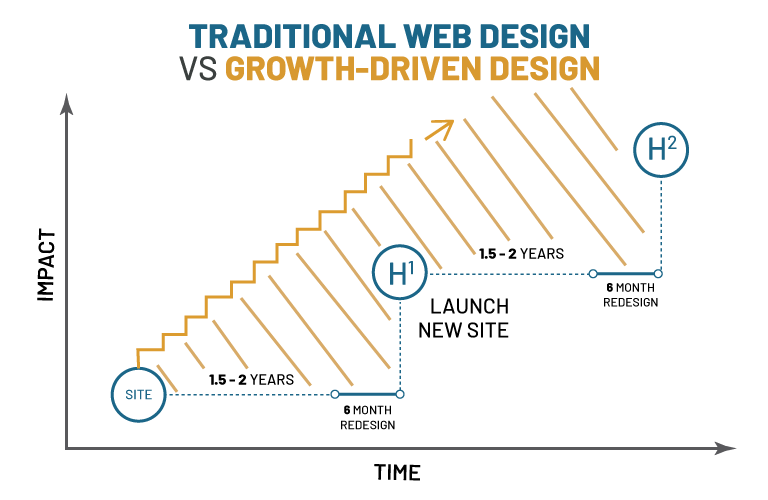Growing a business in the manufacturing industry is no easy task. With the ever-changing online market, it’s becoming more and more clear that companies NEED a solid website to run a successful business, no matter the size of the company.
But why does it have to be such a headache to redesign a website?
In the traditional web design model, changes require a significant investment of both time and money to “refresh” a site with new technology, pages or functionality. Most manufacturing businesses simply don’t have spare time, money or knowledge to do what “should” be done to keep getting worthwhile results. That's where Growth-Driven Web Design (GDD) comes in. With Growth-Driven Web Design, websites are continuously updated every month, with substantive changes to keep your users engaged and moving through the buyer’s journey.
→Read Now: What Is Growth-Driven Web Design? (And Why You Should Care)
Why Traditional Web Design is Outdated for Manufacturing

With traditional web design, countless months are spent building a site that’s designed with only one thing in mind: to launch a website. This website then becomes stagnant, sitting on a single domain only to be refreshed at a significant cost later down the line.
Manufacturing companies usually don’t have the time or resources to know what should be done to continuously provide results from a website, which is where Growth-Driven Design can help.
The challenges with traditional design
Large Up-Front Cost: The average manufacturing business website easily starts at $15,000 depending on the functionality required. At least half of this cost is due at the time of the contract signature, and there’s no telling if the website will perform as advertised. With the seasonality of many manufacturing businesses, this is a huge ask at one time.
Large Time & Resource Commitment: Websites can take between 3-9 months to build (sometimes longer). The web design process will require your time for strategy meetings, content creation, approval of all of the architecture, imagery and everything else that goes into your site. So not only does it cost a lot, it also takes a lot of your time. Oftentimes the process takes so long that by the time your website is finished, it's already outdated.
Over Budget, Not Launched on Time, Not Flexible: People often forget about the systems tied into their website that need to remain in place, especially if you have an internal client portal as many manufacturing business do. This is known as scope creep - wrenches in your process that increase your cost and delay your project.
No Guarantees: You are going to be held to some kind of ROI from your boss for the investment made in your marketing. How can you possibly know (even with your agency’s help) that you’re launching the best performing website? You can look through user data, perform some research and make a hypothesis of what people will like to see, and how to answer their questions. But it’s just that—a hypothesis.
Why Growth-Driven Design is a Better Choice
Instead of working in long, painful chunks of time, what if you performed smaller, incremental improvements consistently? This is the core idea behind Growth-Driven Design.
GDD begins with a dive into buyer persons and your company’s goals. From there, a stream-lined launch pad website is launched. Businesses then have the power to make smaller, more effective changes each week to reach the company goals.
With Growth-Driven Design, you can guarantee that you won’t have a website that collects dust. With GDD, businesses have the control to make incremental changes to the site, so it’s never stagnant.
The three goals of Growth-Driven Design in the manufacturing industry
Growth-Driven Design aims to accomplish 3 main goals:
1. Minimize Challenges: You can eliminate the challenges of traditional web design by focusing on impact, learning, and continuous improvement. In doing so, you’ll be able to shorten the time to launch, taking only 1-3 months, as opposed to the 6–12-month period with the traditional methodology.
2. Continuous Improvement and Learning: Through constant testing and research, you’ll learn more about your users, guiding you toward more effective improvements. Then you’ll be able to test and measure to ensure proven results.
3. As We Learn, Inform Both Marketing and Sales: Marketing and Sales are tightly knit together throughout the entire process. The insights that come from user data will go through them, having a significant impact on sales and marketing strategies.
→Read Now: 10 Reasons Why Growth-Driven Web Design is Better Than Traditional Web Design
The Growth-Driven Design Process
Growth-Driven Design is broken down into three key stages:
1. Strategy
Create a plan for your website to solve problems for your users.
- Business and website goals
- User experience(UX) research
- Jobs to be done
- Fundamental assumptions
- Buyer Personas
- Journey mapping
- Global strategy
- Brainstorm wish list
- Keyword/content plan
- Competitive analysis
2. Launch Pad
Quickly build a website that's better than what you have today, but isn't a final product. Rather, your Launch Pad is the foundation to grow, optimize and build from.
- Customize an acceleration approach
- Run sprint workshops
- Effective content development
- Invest in internal efficiencies
3. Continous improvement
With your Launch Pad website live and collecting data, we'll start identifying high-impact actions to grow your business.
Growth-Driven Web Design is not only easier on your wallet, but it’s also easier on your team and better for your customers. For the manufacturing industry, this streamlined approach allows you to outsource the heavy lifting of updating your website to your web design agency. We've found that many of our manufacturing companies don't care about the fluff - they want the numbers on ROI and lead generation. With GDD, you can more easily pull that data since the entire website is built around monitoring those numbers.
With the ever-changing manufacturing industry, it only makes sense to have an ever-changing website.
An Introduction to Growth-Driven Design
Instead of front-loading web design with a costly and lengthy new design, GDD treats your website like a living entity and focuses on substantive, impactful updates spread throughout the year.
GDD is data-driven, data-proven, and an overall more effective approach to web design.
BizzyWeb is a Minneapolis-based digital marketing and web design agency that helps companies get the high-quality leads they need to grow and thrive. Our tactics include inbound marketing, SEO, advertising, web design, content creation and sales automation. We are an accredited HubSpot Platinum Partner and we offer full-service HubSpot onboarding, enablement and strategy for new and current users.






